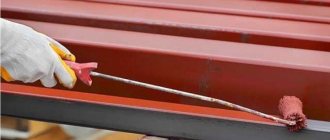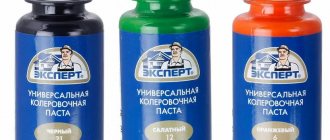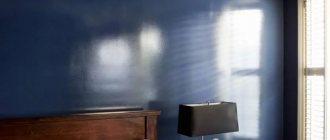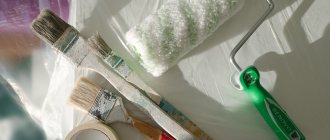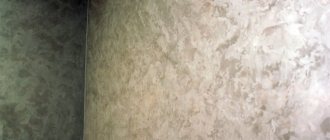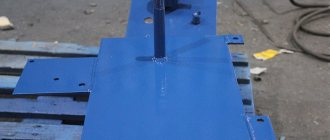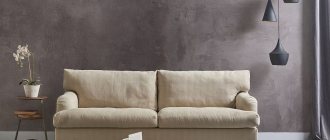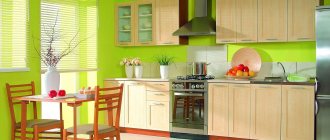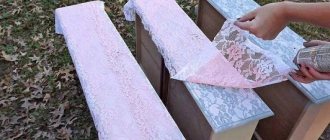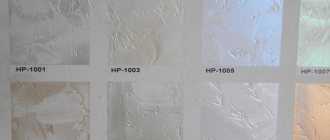There is a huge variety of finishes. As for painting the ceiling, this is a less expensive and lightweight option in terms of its functional qualities. Today the market is replete with many different paint and varnish materials, but it is water-based paint that is in great demand.
This paint material has many different types of painting, for this reason it is difficult to choose the appropriate option for yourself. To make the right choice and understand which water-based paint is better, you need to learn about the experience of other people, based on this, you can already choose something for your purposes.
It also remains to figure out how to best paint with water-based paint yourself. It must be remembered that the correct choice of paint and varnish material directly depends on the result.
Types of water-based paints
Types of paints differ depending on the filler, which is the basis of the mixture:
- Mineral - the composition includes lime and cement. Suitable for treating interior walls. Not popular due to short service life.
- Silicate emulsion paint - colored pigments and liquid glass (silicate) are added to the structure. It is durable, but does not tolerate high humidity.
- Silicone - the versatility of the mixture is due to the silicone resin that makes up the base. It is very resistant to moisture and has the ability to mask small cracks and chips up to 2 mm in size. A wall treated with silicone paint will not mold and fungi will not grow on it. The only drawback is the rather high cost.
- Acrylic water-based paint - despite the high price, is very popular among builders when decorating premises. Used for interior and exterior work. The basis is acrylic resin, which is resistant to changing weather conditions and temperature changes. Apply to concrete, glass, plaster, wood.
- Polyvinyl acetate - based on PVA glue. Painted surfaces can be washed, long service life, low price. But walls turn yellow over time, so it is not advisable to use it in the kitchen, where the atmosphere will contribute to a rapid change in color.
Paints allow you to select suitable shades of colors Source domoholic.ru
Similarity of materials
These common materials have much in common; unlike other coatings, they are characterized by such important properties as:
- ease of operation;
- high drying speed;
- environmental friendliness;
- safety;
- no odor;
- resistance to high humidity;
- color fastness;
- low burnout rate;
- fire properties;
- length of service life.
The choice of shades is large, you can find any color in the palette, which allows you to choose the material to suit any interior. Therefore, they are actively used to implement design ideas. Material based on polyacrylates is often used for painting various decorative elements.
For your information! The water emulsion is suitable for both façade work and finishing of interior walls and ceilings. Compositions based on aqueous dispersion have excellent vapor permeability.
Marking
The letters and numbers on paint cans are easy to decipher if you have an idea of the meaning of each of them.
Letter marking:
- VE – water emulsion.
- VD – water-dispersion paint.
- CN – composed of butadiene-styrene.
- VA – polyvinyl acetate.
- AK – styrene acrylate.
- BC – polyvinyl.
Number 2 indicates emulsion for interior work, number 1 for external walls.
Having an idea of the composition and properties of enamel, it will not be difficult to choose the one that is suitable for the given work.
Composition of water-based paint VEAK 1180
Water-based paint VEAC 1180 is universal, suitable for interior and exterior surfaces. Very resistant to precipitation, walls can be washed. The service life is at least five years, but usually it lasts much longer without noticeable damage.
Components in the enamel structure:
- Acrylic – up to 50%.
- White pigment – 37%.
- Plasticizer – 7%.
- Defoamer – 2%.
- Preservative – 2%.
- Latex – 1%.
- Thickener (CLC glue) – 1%.
In general, the components provide strong adhesion to the surface, resist moisture and mask small cracks and imperfections in the walls.
All the colors of the rainbow Source otdelka-expert.ru
What are the disadvantages of acrylic paint?
Of course, there are disadvantages to the paint coating, but they are quite insignificant if we compare them with the advantages. The disadvantages include the following:
- Price. The composition has a fairly affordable price, but it is higher than some other varieties. with the exception of silicone. However, given that there is no need to apply many layers, the consumption is much more economical. This makes up for the difference in price.
- Low vapor permeability. This property does not always matter. Concrete surfaces, which also have low vapor permeability, are almost universally used in ceilings.
Acrylic paints have no serious disadvantages. However, when choosing a paint and varnish material, you should take into account the purpose of the composition, and also purchase products from trusted brands.
Specifications
Based on the state standard, the technical characteristics of water-based paint VEAC 1180 include the following indicators:
- Viscosity – from 15 to 45 C.
- Density – 1.5 g/cm³.
- Dry residue up to 65%.
- Covering power (ability to hide the previous color) 120 g/m².
- The thickness of one layer is 120 – 170 microns.
- The consumption rate per 1 m² is from 135 to 270 g, depending on the surface material.
- Adhesive component – up to 3 points.
- Complete drying time is no more than 12 hours.
It is allowed to store the finished emulsion at temperatures from +5 to +45, but in hot conditions the shelf life is reduced to 1 month. Freezing is allowed, after which the quality remains unchanged.
See also: Catalog of companies that specialize in paints and varnishes and related work.
Selecting additional components
In addition to pigments and fillers, additives are added to water-based paints that improve the properties of paints and varnishes. Most of them do not play a significant role for the buyer, but there are a number of targeted components that affect the resistance of the coating to external factors.
For facade walls, as well as internal surfaces of the room exposed to moisture or temperature changes, the presence of biocides in the composition is necessary. Such additives do not allow harmful microorganisms (fungi, bacteria) to settle and multiply. Also, for external walls and rooms well lit by the sun, light stabilizers are required to limit color fading and yellowing of the coating.
Coloring mixtures differ in different speeds of complete drying, which occurs over a period of 1 to 4 weeks. Therefore, if you need to paint a room that will soon be commissioned, quick-drying compounds are selected. The likelihood of drip formation depends on the thickening rate indicated on the packaging. It is not advisable to use paints on vertical surfaces that very slowly turn into a dense film.
The quality of the paint and its durability may be reduced if storage conditions are violated at the point of sale. Therefore, it is necessary to check data such as expiration dates, seller certificates (if possible). In non-certified departments, counterfeits of well-known brands are more common, and paints may be kept at sub-zero temperatures, which impair the coloring properties of the product.
When choosing paint for walls, you should spend enough time studying its technical characteristics and composition. It is important to follow the instructions not only when purchasing, but also when storing and applying the mixture to the surface. It is not advisable for the paint to be stored for a long time or used at temperatures below 5 degrees Celsius. Don’t forget about purchasing high-quality painting tools (roller, brush, spray gun), as well as careful preliminary preparation of the walls. This is the only way to preserve the declared properties of paintwork materials and obtain a high-quality, reliable result.
Advantages and disadvantages
The technical characteristics of water-based paint VAEK 1180 include its absolute non-flammability, neutral attitude towards aggressive environments and environmental friendliness.
White paint Source gidpokraske.ru
Other benefits:
- Easy to use. Can be diluted with plain water from a tap or well; after use, the instrument can also be easily washed in running water.
- Non-toxic and hypoallergenic - suitable for use in children's institutions.
- Strong adhesion to many types of materials. Works well on putty, concrete, wood, plaster. The exception is metal surfaces - here you will have to choose a different type of enamel.
- After painting, you can immediately live in the room. Does not leave unpleasant odors characteristic of oil or synthetic enamel.
- Dries quickly. Design drying time is from 5 to 12 hours.
- During storage it remains smooth and uniform, does not delaminate or crumble.
- Painted walls are easy to clean without leaving streaks. Has antibacterial properties.
- Permits air (breathes), resists moisture. Can be used in the bathroom and kitchen.
There are some minor disadvantages:
- It is impossible to work at sub-zero temperatures. The aqueous solvent freezes, depriving the dye of its viscosity.
- No adhesion to glossy or metal surfaces. The reason is the same: the water component.
Walls painted with water-based emulsion Source remontidei.ru
Which water-based emulsion to choose?
When choosing a material for painting a ceiling, every owner of an apartment or house should remember the axiom: the best option is water-based paint. This is due to a number of undoubted advantages that it has compared to others:
- Absolutely harmless to humans and do not require special protective measures when performing work. Water emulsions do not emit harmful toxins or odors.
- Can be easily tinted using pigments specially designed for water-based emulsions. It is enough just to thoroughly mix the paint with the selected color.
- If water emulsion gets on furniture, the floor, or gets your hands dirty, you can immediately wash it off with plain water.
Therefore, the main problem that a person will face is which water-based paint is best to choose for painting the ceiling.
When choosing which ceiling paint is the best water-based paint, you need to focus on the following initial data:
- type of room;
- terms of Use;
- required appearance;
- available budget.
Therefore, in order to choose the right paint for the ceiling, you need to correctly assess the future operating conditions of the room. If you plan to paint the ceiling in an apartment or house in an ordinary living room in the absence of humidity and temperature changes, as well as with good preparatory finishing of the surfaces to be painted, then ordinary polyvinyl acetate or silicate water-based paints will be a sufficient option. This will save money, especially if the painting area is large.
In rooms with high humidity (bathroom, kitchen), as well as in rooms at risk of moisture penetration (upper floors, corner rooms), acrylic or latex ceilings are a good option. Also, latex-based paints have the best glossy effect. The cost of such paints will be higher.
If the surface to be painted is not well prepared, and you also want to make the most of the benefits of water-based emulsions, then it is better to choose silicone paint. Using the above recommendations, you will not get lost when searching for the answer to the question of how to choose the right method of painting the ceiling.
How to paint a ceiling (2 videos)
Water-based paint of different brands (28 photos)
Painting tools
Before starting finishing work, prepare the necessary tools, which should always be at hand.
Types of tools:
- The roller is foam rubber or fleecy.
- Paint brush for painting hard-to-reach places.
- Masking tape.
- Spatula for cleaning walls and mesh for sanding.
- Sponge.
- Paint tray.
- A bucket for putty.
- Ladder or trestle.
A set of tools for work Source remitek.ru
Preparing walls for painting
Worn surfaces with stains, cracks, chips and potholes are subject to repair. You can't paint them, it's a waste of material and time. Before starting painting work, the walls should be prepared.
- Wall cleaning.
Oil paint, old plaster and simply cracked areas are removed using a spatula. Oil paint is preheated with a construction hairdryer. The lime is soaked and washed off with a brush or hard sponge.
If the surface is smooth, you just need to remove the old coating - use a grinding machine.
- Sealing irregularities.
The cracks and cracks are carefully cleaned and slightly widened so that there are no loose edges left. Then putty or seal with silicone and leave until completely dry.
Dry areas are sanded smooth and dust is swept away.
- Decoration of corners.
Corners left neglected will ruin the beauty of the renovated room. They are decorated with a silicone corner and puttied. Then they clean and polish.
- Preparation of reinforced walls.
Surfaces with metal reinforcement are puttied to hide the mesh and make the wall smooth. To avoid rust, the metal part is treated or paint with anti-corrosion properties is selected.
Material Compatibility
Many people are concerned about the question of whether it is possible to apply acrylic paint to water-based paint. Often during the renovation process it is necessary to treat surfaces that already have a finish. The water emulsion-based material is perfect for surfaces made of concrete, brick, and fits well on a plastered wall. But it cannot be used to decorate previously painted walls.
Compositions based on polyacrylates will come to the rescue. They are resistant to damage, do not crack, and form a dense elastic film on the surface. Used to decorate wood, glass, and metal. Water-based paint cannot be used over another dye, unlike acrylic paint.
A product containing polyacrylates is often specially applied to the emulsion layer. It is important to wait until the surface is completely dry, otherwise the paint will curl up in lumps. This is convenient when it is not possible to completely remove the old coating. Another important point is that applying acrylic paint over emulsion paint is only possible if the surface is smooth, without visible damage, peeling, or swelling.
Since many works were previously carried out with oil-based compounds, the question arises whether it is possible to paint with water-based paint over oil-based paint. It is not advisable to do this, since during operation it will become clear that the water-based emulsion quickly wears off. It is allowed to do this provided that the conditions are met that the surface will not be used intensively. To ensure longer service life, it is advisable to make several layers.
It is impossible to answer unequivocally the question of which is better – acrylic paint or water-based paint. It all depends on the material of the surface being treated and operating conditions. Everyone chooses paint for renovation work based on these conditions. However, materials based on water emulsion and polyacrylates enjoy the well-deserved love of customers due to the fact that they provide a reliable, stable and safe coating.
Video description
For useful tips on painting, watch this video:
After long-term storage or defrosting, check the quality of the application on the wall.
Then they are tinted with a previously prepared colorant. You need to dilute the entire jar with color at once to get a homogeneous mass. Color paint is prepared 10 percent more than necessary in order to leave a little of the same color in stock. Sometimes you have to renew some areas so that the color does not differ. The color is made a little darker than desired, because after drying it becomes lighter.
Paint a small section of the wall and determine the result achieved. If the color is right, you can start.
Manufacturers produce ready-made colored VE mixtures, so you don’t have to bother with tinting, but just take a ready-made one.
Video description
You can see how to paint walls when carrying out repair work in this video:
Layer after layer is overlapped by 5-10 cm, so there will be no gaps and the boundaries of the previous layer will not be visible.
Application is carried out as quickly as possible, so that later drying occurs more evenly and the VE does not have time to thicken.
The ceiling and high walls are painted with a roller mounted on a long rod.
For large volumes use a spray gun. The speed of the mechanism is up to 150 kW. m/hour.
Allow the surfaces to dry for an hour and repeat the application of VE perpendicular to the previous layer.
They check for any flaws and correct them immediately, without waiting for complete drying.
During painting, horizontal and vertical layers alternate Source guruotdelki.ru
Briefly about the main thing
Even a novice craftsman can use water-based paint.
A large selection of “water emulsions” will make it possible to choose exactly your option.
Acrylic paint VEAC 1180 is a leader among similar materials.
Resistance to humidity and environmental friendliness make it possible to use “water emulsions” in bathrooms, kitchens and children's bedrooms.
Painting rules require that work be done quickly so that the composition does not have time to thicken or dry out excessively.
Ratings 0
How are acrylic and water-based dispersion related?
Many people believe that acrylic and water-based paint are identical concepts. This is not entirely true; it is important to understand the difference between acrylic paint and water-based paint. Water emulsion is a general concept that includes a whole group of dyes. This includes compositions based on silicone, minerals, silicates - sand, liquid glass, resin.
Acrylic dyes are one of the types of water-based compositions. They are created on the basis of polyacrylates, which provide them with high quality and technical characteristics. That is why the variety of acrylic-based paints and varnishes is the most popular at present.
